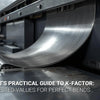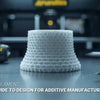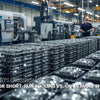How Can You Prevent Thread Failure in Die Cast Aluminum Parts?

How Can You Prevent Thread Failure in Die Cast Aluminum Parts?

Stripped threads in die-cast aluminum parts cost manufacturers thousands of dollars in rework, warranty claims, and production delays every year. If you've ever watched a screw spin uselessly in a once-secure threaded hole, you know the frustration of dealing with soft aluminum that simply won't hold fasteners reliably. This problem affects everything from automotive components to industrial machinery, where repeated assembly cycles or vibration loads expose the inherent weakness of tapped threads in cast aluminum.
Quick Answer: Your Thread Strength Solutions at a Glance
| Solution Type | Strength Rating | Best For | Cost Level |
|---|---|---|---|
| Molded-In Inserts | Highest (8-10x stronger) | High-vibration, critical assemblies | Higher upfront, lower at volume |
| Ultrasonic Inserts | High (5-7x stronger) | Retrofit applications, medium loads | Medium |
| Press-Fit Inserts | Medium (3-5x stronger) | General purpose assemblies | Low to Medium |
| Helicoil/Thread Repair | Medium (4-6x stronger) | Thread repair, field service | Low |
| Self-Tapping Screws | Low (2-3x stronger) | Light-duty, non-critical joints | Lowest |
Bottom line: Molded-in inserts provide the strongest solution but require design planning, while post-molded options offer flexibility for existing parts. Your choice depends on production volume, load requirements, and budget constraints.
Understanding these options helps you match the right fastening solution to your specific application. Whether you're designing new die-cast components or fixing existing thread problems, the following guide walks you through each method with real performance data and practical implementation advice.
Table of Contents
- Why Do Threads Strip So Easily in Die Cast Aluminum Parts?
- What Makes Molded-In Inserts the Strongest Solution?
- Which Post-Molded Insert Method Works Best for Your Application?
- How Do You Choose Between Cost and Performance?
- Conclusion
Why Do Threads Strip So Easily in Die Cast Aluminum Parts?
Die-cast aluminum parts offer excellent strength-to-weight ratios and complex geometry capabilities, but they hide a critical weakness that catches many engineers by surprise. The very process that makes die casting so cost-effective also creates internal structures that perform poorly when threaded fasteners need reliable holding power.
The Core Problem with Thread Strength Die Casting Insert Applications
Die-cast aluminum suffers from four material characteristics that undermine thread integrity:
- Porous outer skin reduces the actual contact area between threads and base material by 30-50%
- Soft internal structure provides inadequate thread engagement compared to wrought or forged aluminum
- Coarse grain boundaries create stress concentration points where cracks initiate under cyclic loads
- Typical pull-out strength reaches only 30-40% of equivalent solid aluminum stock
These limitations mean that directly tapped threads work only for very low-stress applications where disassembly rarely occurs. Once you introduce vibration, thermal cycling, or repeated assembly operations, standard tapped threads fail quickly and unpredictably.

Understanding Why the Casting Process Creates Weak Threads
The die casting process involves injecting molten aluminum into steel molds under high pressure. While this creates parts with excellent surface finish and dimensional accuracy, the rapid cooling rates and high injection speeds trap gas bubbles within the solidifying metal. These tiny voids congregate near the surface, creating what metallurgists call "skin porosity."
When you tap threads into this porous surface layer, the cutting tool removes much of the already-limited solid material. As a result, the remaining thread profile has gaps and discontinuities that drastically reduce load-bearing capacity. Furthermore, the aluminum alloys commonly used in die casting (such as A380 or ADC12) prioritize castability and fluidity over mechanical strength, which compounds the problem.
Real-world testing shows dramatic differences in performance. For instance, a standard M6 thread tapped directly into die-cast aluminum typically fails at 100-150 pounds of pull-out force, whereas the same thread in 6061-T6 machined aluminum withstands 400-500 pounds. This three-to-five-fold difference explains why assemblies that work perfectly in prototypes (often machined from solid stock) fail repeatedly in production die castings.
Repeated assembly cycles accelerate the degradation. Each time you remove and reinstall a screw, the soft aluminum deforms slightly, work-hardens, and develops microcracks. After just 5-10 assembly cycles, pull-out strength often drops by an additional 40-60%, turning marginally adequate joints into reliability nightmares.
What Makes Molded-In Inserts the Strongest Solution?
Molded-in inserts represent the gold standard for threaded fastening in die-cast parts because they fundamentally solve the material weakness problem. Instead of relying on the porous aluminum to provide thread engagement, these inserts become permanent structural elements embedded directly into the casting during the molding process.
Key Performance Advantages of Molded-In Threaded Inserts
When comparing molded-in inserts vs post-molded solutions, the performance differences prove substantial:
- Pull-out strength: 800-1,200 lbs for M6 inserts (versus 100-150 lbs for tapped threads)
- Mechanical interlocking: Molten aluminum flows around knurled or grooved insert surfaces, creating both mechanical and metallurgical bonds
- No secondary operations: Parts emerge from the die ready for assembly, eliminating bottlenecks
- Vibration resistance: The complete encapsulation prevents loosening under dynamic loads
These performance gains make molded-in inserts essential for critical applications in automotive and industrial machinery where field failures carry high costs. Additionally, the complete 360-degree support provided by the surrounding aluminum prevents the insert from rotating or pulling out under torque loads.
Design Considerations and Implementation Details
Successfully implementing threaded inserts for die casting requires careful attention to several technical factors. First, insert material selection matters significantly—brass inserts offer excellent thermal expansion compatibility with aluminum alloys, while stainless steel provides superior corrosion resistance in harsh environments. The knurl pattern must provide adequate mechanical retention without creating stress concentrations that could initiate cracks.
Insert positioning within the die presents unique challenges. Engineers must account for molten metal flow patterns to ensure complete fill around the insert without creating air pockets or cold shuts. Proper venting becomes critical, as trapped gases can prevent full encapsulation and compromise strength. Moreover, the insert must be held securely in position during the high-pressure injection cycle, typically requiring specialized core pins or mechanical retention features in the die design.
Wall thickness around the insert directly impacts strength and casting quality. Industry best practices recommend minimum wall thickness of twice the insert diameter to prevent sink marks, porosity, and mechanical weakness. For example, an M6 insert (approximately 9mm outer diameter) requires at least 18mm of surrounding wall thickness for optimal performance.
Thermal expansion differences between steel or brass inserts and aluminum castings create residual stresses as parts cool. Therefore, insert manufacturers design specific knurl patterns and geometries that accommodate these stresses while maintaining mechanical lock. Quality control becomes paramount—each insert must be properly positioned and fully encapsulated, requiring visual inspection or destructive testing during production validation.
From a cost perspective, molded-in inserts add complexity and expense to die design and per-part costs. However, production volumes above 10,000 units annually typically show favorable economics because the elimination of secondary operations reduces total manufacturing cost. The breakeven point varies by part complexity and labor rates, but high-volume manufacturers consistently find molded-in inserts more economical than post-processing alternatives.
Which Post-Molded Insert Method Works Best for Your Application?
Post-molded installation methods provide valuable flexibility when molded-in inserts aren't feasible due to design constraints, existing tooling limitations, or low production volumes. These approaches add threaded inserts after casting, offering different trade-offs between strength, cost, and installation complexity.
Comparing Four Major Post-Processing Approaches
Ultrasonic Insertion
Ultrasonic insertion die casting technology uses high-frequency vibration (typically 20-40 kHz) to melt a thin layer of aluminum as the insert is pressed into a pre-drilled hole. This creates a partial metallurgical bond combined with mechanical retention from the insert's knurl pattern.
- Installation time: 2-5 seconds per insert with automated equipment
- Pull-out strength: 400-700 lbs for M6 inserts
- Best for: Production retrofits, existing parts requiring strength upgrades
- Equipment cost: $15,000-$50,000 for ultrasonic insertion systems
The process generates minimal stress in surrounding material, making it suitable for thin-wall sections where press-fit methods might crack the casting. However, operator skill significantly affects quality, as improper insertion depth or insufficient vibration time compromises bond strength.
Press-Fit Inserts
Press-fit installation relies purely on mechanical interference between the insert's outer diameter and a precisely sized hole. The insert features sharp knurls or helical grooves that cut into the aluminum during installation, creating mechanical retention.
- Installation: Simple pneumatic press or arbor press
- Pull-out strength: 300-500 lbs for M6 inserts
- Best for: General assemblies, cost-sensitive projects
- Equipment cost: $500-$5,000 for basic pressing fixtures
Press-fit methods work well when hole diameter tolerance can be tightly controlled (typically ±0.025mm). Nevertheless, the installation force creates significant radial stress, requiring adequate wall thickness to prevent cracking. This method offers the lowest equipment investment but provides less strength than ultrasonic or molded-in alternatives.
Helicoil and Keensert Thread Repair Systems
When discussing Helicoil vs molded inserts, it's important to understand that Helicoil-style wire thread inserts serve different purposes. These coiled wire inserts install into a specially tapped hole, providing wear-resistant internal threads that distribute loads across a larger area.
- Installation: Drill oversized hole, tap with special tap, wind in coil insert
- Pull-out strength: 350-600 lbs for M6 inserts
- Best for: Field repairs, thread restoration, prototype work
- Equipment cost: $50-$500 for tap sets and installation tools
Helicoil systems excel at aluminum casting thread repair scenarios where existing threads have stripped or when field service personnel need to restore thread integrity without specialized equipment. The installation process requires more steps than other methods, but the tools are portable and widely available. Additionally, the spring-like coil design absorbs some vibration and shock loads, providing good performance in dynamic applications.
Self-Tapping Inserts
Self-tapping screws die casting applications use specially designed inserts that cut or form their own threads during installation with a power driver. These provide the quickest installation but lowest performance.
- Installation: Power driver installation in 1-3 seconds
- Pull-out strength: 200-350 lbs for M6 inserts
- Best for: Non-critical, light-load applications, rapid prototyping
- Equipment cost: $100-$1,000 for power drivers
Self-tapping inserts work adequately for electrical enclosures, trim panels, and other low-stress applications. However, the thread-forming action creates significant stress in the already-weak die-cast material, limiting their use in structural or high-cycle applications.
Selecting the Right Method for Your Production Environment
Each post-molded method occupies a specific niche in manufacturing operations. Ultrasonic insertion delivers the best strength-to-cost ratio for medium and high-volume production, especially when retrofitting existing designs where die modifications aren't feasible. The technology scales well with automation, making it increasingly cost-effective as volumes increase beyond 5,000 units annually.
Press-fit inserts suit lower-volume applications where equipment investment must be minimized. They also work well for manual assembly operations or when production volumes don't justify ultrasonic equipment. In contrast, quality consistency can vary more than ultrasonic methods due to greater dependence on hole preparation and operator technique.
Helicoil and similar wire insert systems remain the preferred choice for field service, maintenance operations, and thread repair situations. Their portability and minimal equipment requirements make them invaluable when threads fail in service or when prototype parts need threaded holes before production tooling exists. Many companies stock Helicoil installation kits specifically for thread repair emergencies.
Self-tapping inserts fill the gap for non-critical assemblies where cost and installation speed matter more than ultimate strength. Consumer products, electronics enclosures, and decorative assemblies often use self-tapping inserts successfully. Meanwhile, engineers should avoid them in any application involving vibration, thermal cycling, or safety-critical fastening.
How Do You Choose Between Cost and Performance?
The decision between molded-in inserts and post-processing methods ultimately comes down to balancing performance requirements against manufacturing economics. Neither approach is universally superior—the right choice depends on your specific application, production volume, and failure consequences.
Decision Framework: When to Choose Each Approach
Choose Molded-In Inserts When:
- Production volume exceeds 10,000 units per year, allowing tooling costs to amortize
- Vibration, shock loads, or thermal cycling create demanding service conditions
- Field failures would result in warranty claims, safety issues, or brand damage
- Assembly and disassembly cycles exceed 10 over the product's lifetime
- Manufacturing process can accommodate die complexity and longer cycle times
Choose Post-Molded Solutions When:
- Retrofitting existing designs where die modifications aren't economically justified
- Production volumes fall under 5,000 units per year
- Design flexibility is needed during development or for product variants
- Tooling budget limitations prevent die modifications
- Thread locations or quantities change between product versions
For applications in the gray area between 5,000 and 10,000 annual units, detailed cost analysis becomes essential. Additionally, consider the strategic value of design flexibility versus manufacturing simplification when making this decision.
Real-World Cost Analysis and ROI Considerations
Understanding the total cost picture requires looking beyond just part cost to include tooling, labor, quality, and failure costs. Molded-in inserts typically add $0.50-$2.00 per insert to die casting costs, depending on insert complexity and quantity. However, this must be compared against the total cost of post-processing operations.
For example, ultrasonic insertion adds $0.30-$0.80 per insert in direct costs (insert cost, labor, equipment depreciation, and quality inspection). At 10,000 units annually with four inserts per part, ultrasonic insertion costs $12,000-$32,000 per year in ongoing expenses. Meanwhile, molded-in inserts might add $20,000-$40,000 to die tooling but only $0.50-$1.00 per part ($20,000-$40,000 annually at the same volume).
The crossover point typically occurs around 8,000-12,000 units annually, but several other factors influence the calculation. Higher labor rates favor molded-in inserts by increasing the relative cost of secondary operations. Complex parts with many inserts amplify the economics in favor of molded-in solutions because the marginal die cost per insert decreases while post-processing costs scale linearly.
Failure costs often dwarf manufacturing cost differences. Consider an automotive component where field failures trigger warranty claims averaging $200 per incident. If inadequate thread strength causes failures in just 2% of units, that's $40,000 in warranty costs on 10,000 units—more than enough to justify the premium solution. For industrial machinery applications, unplanned downtime and service calls can cost thousands of dollars per incident, making robust fastening solutions essential regardless of initial part cost.
Quality and consistency considerations also factor into the decision. Molded-in inserts eliminate variation from secondary operations, reducing defect rates and inspection requirements. Post-processing methods introduce additional process steps where operator error, equipment malfunction, or material variation can compromise quality. Companies with strict quality requirements or complex supply chains often prefer molded-in inserts to reduce the number of process control points.
Design flexibility represents the major advantage of post-molded approaches. Early in product development when thread locations, sizes, or quantities remain uncertain, delaying the insert decision until after casting provides valuable adaptability. Similarly, product families sharing common castings but requiring different fastening arrangements benefit from post-molded flexibility. In these scenarios, the manufacturing cost premium may be worthwhile to avoid expensive die modifications or multiple die variants.
Similar flexibility advantages apply to methods like investment casting, where insert placement during the casting process requires different considerations but follows similar economic principles regarding the balance between in-process integration and post-processing flexibility.
Conclusion
Thread failure in die-cast aluminum parts stems from fundamental material limitations that cannot be overcome through careful tapping or special thread profiles alone. The porous structure and soft alloys used in die casting simply cannot provide adequate thread engagement for demanding applications. Consequently, engineers must choose between molded-in inserts that become integral structural elements or post-molded solutions that add strength through secondary operations.
The right solution depends on three primary factors: application requirements, production volume, and budget constraints. Therefore, start by evaluating pull-out force requirements, vibration exposure, and assembly cycle expectations to establish minimum performance thresholds. Then match these requirements to production reality—high volumes favor molded-in inserts, while lower volumes and design flexibility needs point toward post-processing methods.
Moreover, don't underestimate the value of preventing field failures through robust fastening solutions. The incremental cost of proper inserts typically represents a fraction of warranty claims, customer dissatisfaction, and brand damage from stripped threads. By treating thread strength as a critical design parameter rather than an afterthought, you can avoid the costly cycle of failure, rework, and retrofit that plagues many die-cast products.
Whether you choose molded-in brass inserts for maximum strength, ultrasonic insertion for retrofit flexibility, or Helicoil repairs for field service, the key is matching the solution to your specific needs rather than defaulting to the lowest-cost option. In threaded fastening, as in most engineering decisions, understanding the trade-offs allows you to make informed choices that balance cost, performance, and risk effectively.
Recommended Resources
[Thread strength die casting insert][^1]
[Threaded inserts for die casting][^2]
[Ultrasonic insertion die casting][^3]
[Self-tapping screws die casting][^4]
[Helicoil vs molded inserts][^5]
---
[^1]: Understanding thread strength die casting inserts is crucial for ensuring durability and performance in manufacturing processes.
[^2]: Exploring the use of threaded inserts can enhance your knowledge of die casting applications and improve product quality.
[^3]: Learn about the innovative process of ultrasonic insertion die casting and its benefits for manufacturing efficiency and product quality.
[^4]: Explore this link to understand the benefits and uses of self-tapping screws in die casting, enhancing your project knowledge.
[^5]: Discover the pros and cons of Helicoil and molded inserts to make informed decisions for your fastening needs.





